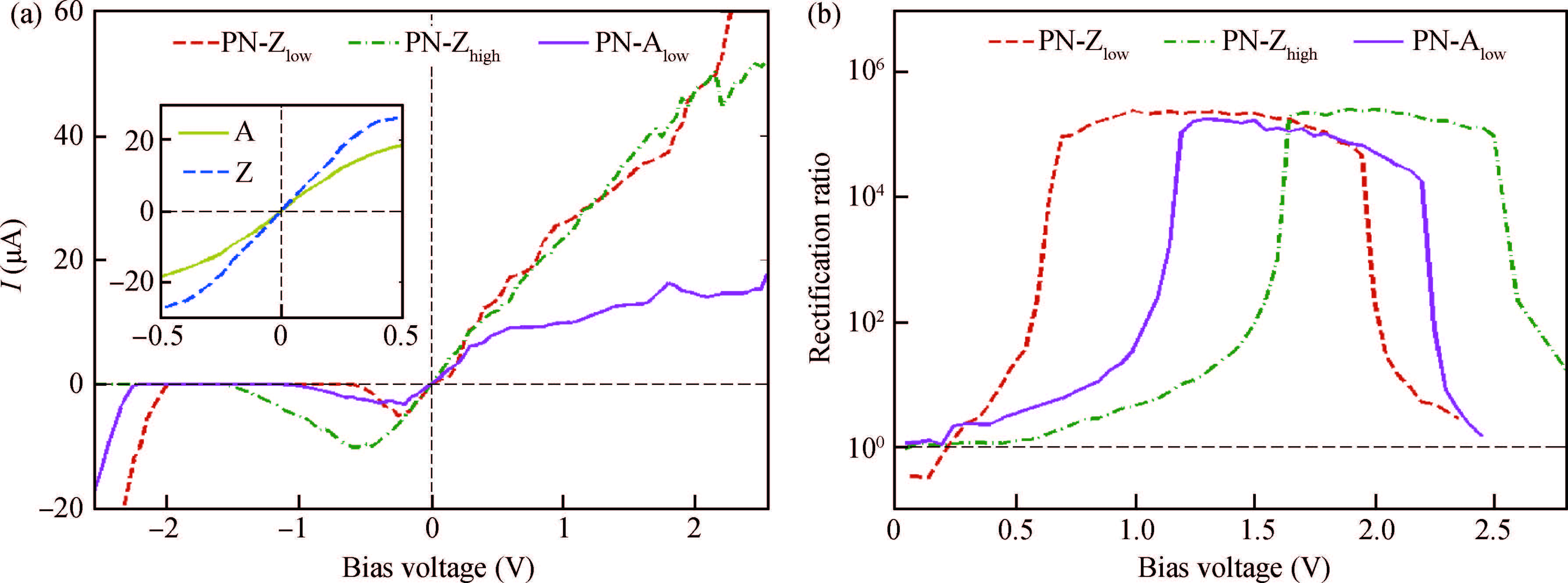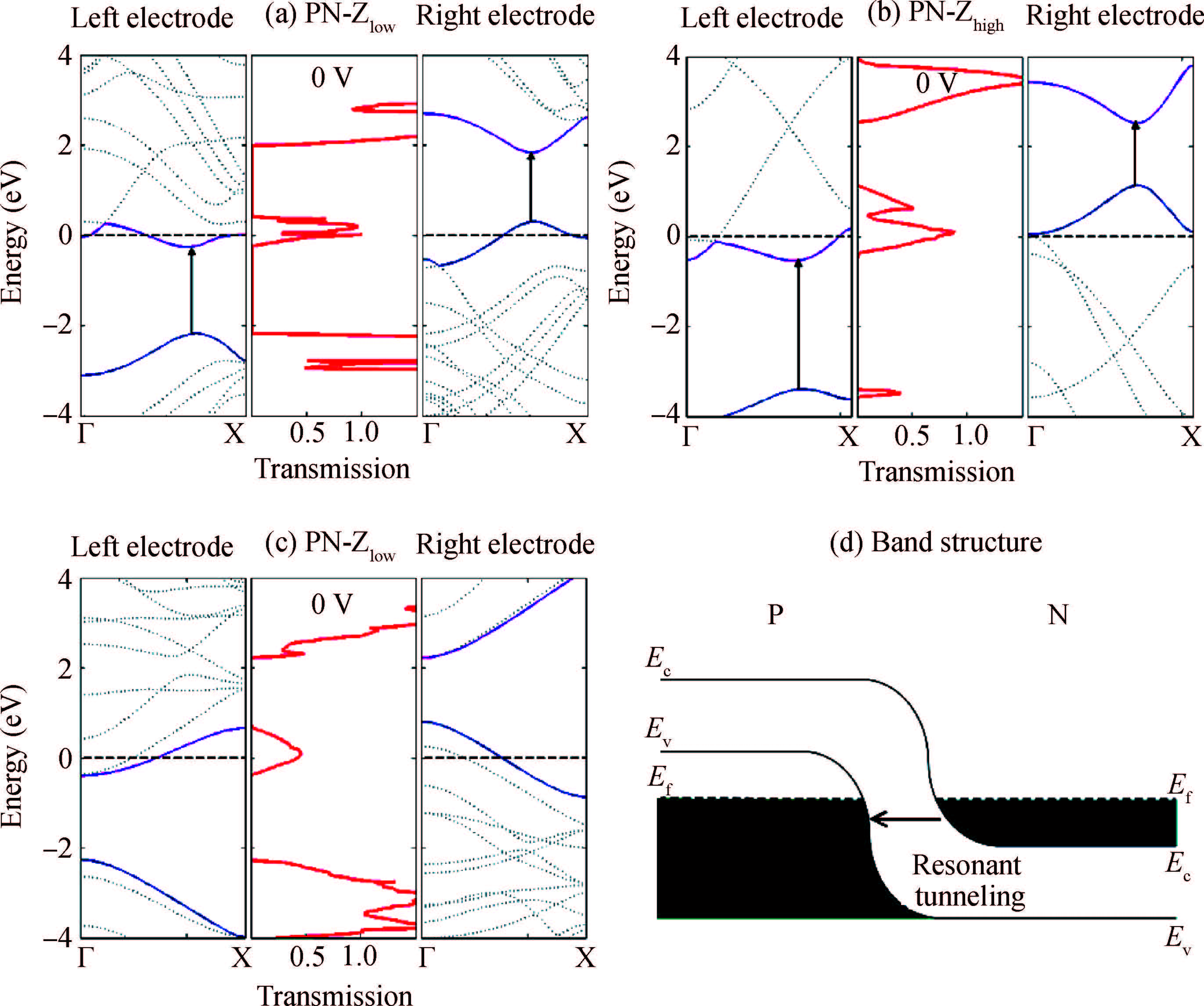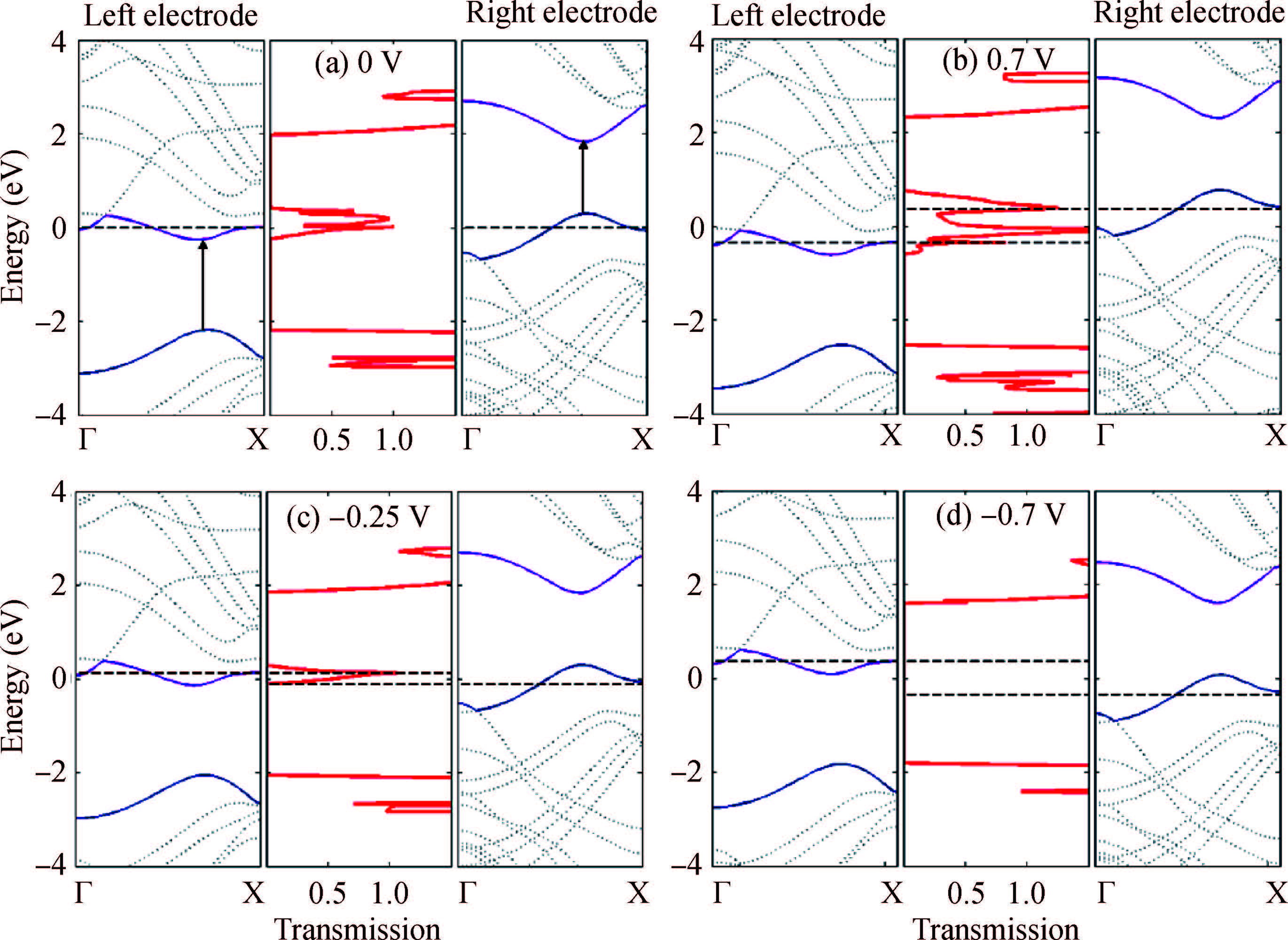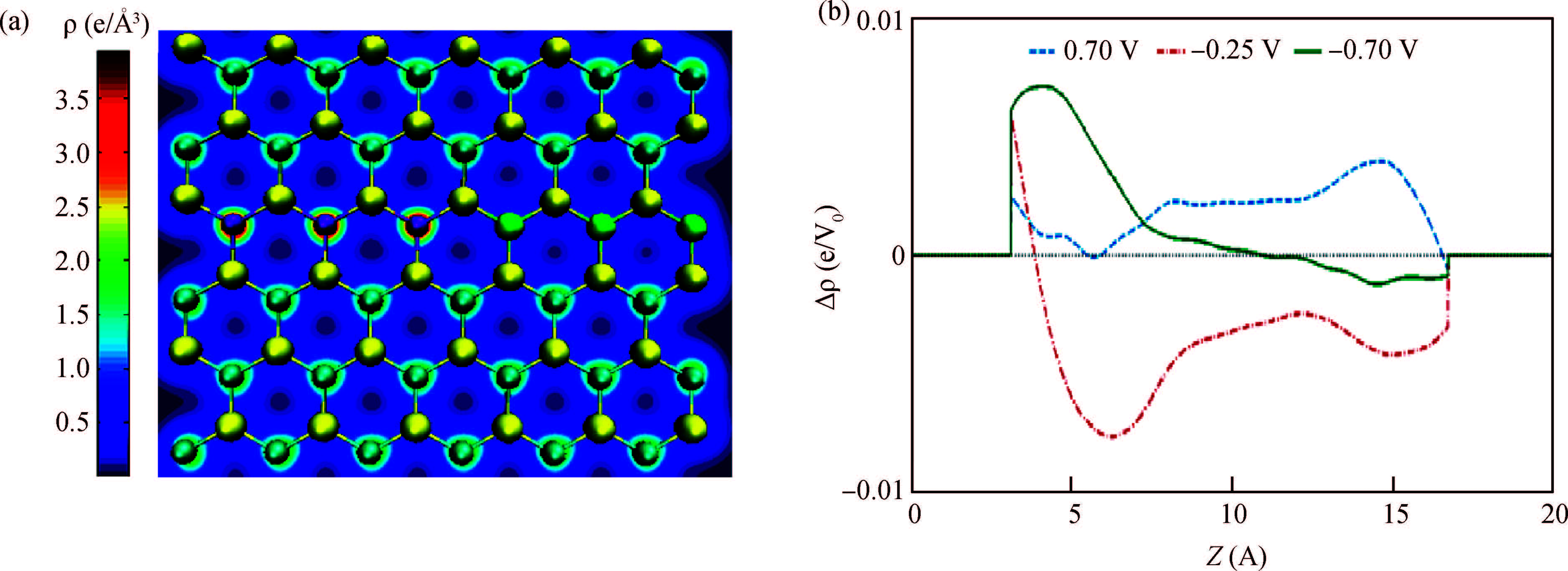| Citation: |
Hanming Zhou, Xiao Lin, Hongwei Guo, Shisheng Lin, Yiwei Sun, Yang Xu. Ab initio electronic transport study of two-dimensional silicon carbide-based p-n junctions[J]. Journal of Semiconductors, 2017, 38(3): 033002. doi: 10.1088/1674-4926/38/3/033002
****
H M Zhou, X Lin, H W Guo, S S Lin, Y W Sun, Y Xu. Ab initio electronic transport study of two-dimensional silicon carbide-based p-n junctions[J]. J. Semicond., 2017, 38(3): 033002. doi: 10.1088/1674-4926/38/3/033002.
|
Ab initio electronic transport study of two-dimensional silicon carbide-based p-n junctions
DOI: 10.1088/1674-4926/38/3/033002
More Information
-
Abstract
Two-dimensional silicon carbide (2d-SiC) is a viable material for next generation electronics due to its moderate, direct bandgap with huge potential. In particular, its potential for p-n junctions is yet to be explored. In this paper, three types of 2d-SiC-based p-n junctions with different doping configuration are modeled. The doping configurations refer to partially replacing carbon with boron or nitrogen atoms along the zigzag or armchair direction, respectively. By employing density functional theory, we calculate the transport properties of the SiC based p-n junctions and obtain negative differential resistance and high rectification ratio. We also find that the junction along the zigzag direction with lower doping density exhibits optimized rectification performance. Our study suggests that 2d-SiC is a promising candidate as a material platform for future nano-devices.-
Keywords:
- SiC,
- transport,
- two-dimension
-
References
[1] Bekaroglu E, Topsakal M, Cahangirov S, et al. First-principles studyofdefects andadatomsin siliconcarbide honeycombstructures. Phys Rev B, 2010, 81:075433 doi: 10.1103/PhysRevB.81.075433[2] Wu R, Zhou K, Yue C Y, et al. Recent progress in synthesis, properties and potential applications of SiC nanomaterials. Prog Mater Sci, 2015, 72:1 doi: 10.1016/j.pmatsci.2015.01.003[3] Li X W, Zhou J, Wang Q, et al. Magnetic properties of two dimensional silicon carbide triangular nanoflakes-based kagome lattices. Nanopart Res, 2012, 14:1056 doi: 10.1007/s11051-012-1056-5[4] Lin X, Lin S, Xu Y, et al. Ab initio study of electronic and optical behavior of two-dimensional silicon carbide. J Mater Chem C, 2013, 1:2131 doi: 10.1039/c3tc00629h[5] Lou P J. Effects of edge hydrogenation in zigzag silicon carbide nanoribbons:stability,electronicandmagneticproperties,aswell as spin transport property. J Mater Chem C, 2013, 1:2996 doi: 10.1039/c3tc30173g[6] Lin S S. Light-emitting two-dimensional ultrathin silicon carbide. J Phys Chem C, 2012, 116:3951 doi: 10.1021/jp210536m[7] Ivanov P A, Chelnokov V E. Recent developments in SiC singlecrystal electronics. Semicond Sci Technol, 1992, 7:863 doi: 10.1088/0268-1242/7/7/001[8] Freeman C L, Claeyssens F, Allan N L. Graphitic nanofilms as precursors to wurtzite films:theory. Phys Rev Lett, 2006, 96:066102 doi: 10.1103/PhysRevLett.96.066102[9] Ding Y, Wang Y L. Density functional theory study of the silicene-like SiX and XSi3(X D B, C, N, Al, P) honeycomb lattices:the various buckled structures and versatile electronic properties. J Phys Chem C, 2013, 117:18266 doi: 10.1021/jp407666m[10] Mak K F, Lee C, Hone J, et al. Atomically thin MoS2:a new direct-gap semiconductor. Phys Rev Lett, 2010, 105:474[11] Lin X, Lin S, Xu Y, et al. Electronic structures of multilayer twodimensional silicon carbide with oriented misalignment. J Mater Chem C, 2015 https://www.researchgate.net/publication/280062997_Electronic_structures_of_multilayer_two-dimensional_silicon_carbide_with_oriented_misalignment[12] Sahin H, Cahangirov S, Topsakal M, et al. Monolayer honeycomb structures of group-IV elements and Ⅲ-V binary compounds:first-principles calculations. Phys Rev B, 2009, 80:155453 doi: 10.1103/PhysRevB.80.155453[13] Brander R W, Sutton R P. Solution grown SiC p-n junctions. J Phys D, 1969, 2:309 doi: 10.1088/0022-3727/2/3/301[14] Mitlehner H, Friedrichs P, Peters D, et al. Switching behavior of fast high voltage SiC pn-diodes. IEEE Proceedings of the 10th Int Symposium on Power Semiconductor Devices and ICs, 1998:127[15] Gupta J P, Andrainov A V, Kolodzey J, et al. Injection induced terahertz electroluminescence from 4H-SiC pn-junctions under forward bias. IEEE Infrared, Millimeter, and Terahertz Waves (IRMMW-THz), 38th Int. Conference, 2013:1[16] Novoselov K S, Geim A K, Morozov S V, et al. Two-dimensional gas of massless Dirac fermions in graphene. Nature, 2005, 438:197 doi: 10.1038/nature04233[17] Geim A K, Novoselov K S. The rise of graphene. Nat Mater, 2007, 6:183 doi: 10.1038/nmat1849[18] Mak K F, Sfeir M Y, Wu Y, et al. Measurement of the optical conductivity of graphene. Phys Rev Lett, 2008, 101:196405 doi: 10.1103/PhysRevLett.101.196405[19] Nair R R, Blake P, Grigorenko A N, et al. Fine structure constant defines visual transparency of graphene. Science, 2008, 320:1308 doi: 10.1126/science.1156965[20] Novoselov K S, Jiang D, Schedin F, et al. Two-dimensional atomic crystals. Proc Natl Acad Sci USA, 2005, 102:10451 doi: 10.1073/pnas.0502848102[21] Pacilé D, Meyer J C, Girit Ç Ö, et al. The two-dimensional phase of boron nitride:few-atomic-layer sheets and suspended membranes. Appl Phys Lett, 2008, 92:133107 doi: 10.1063/1.2903702[22] Meyer J C, Chuvilin A, Algara-Siller G J, et al. Selective sputtering and atomic resolution imaging of atomically thin boron nitride membranes. Nano Lett, 2009, 9:2683 doi: 10.1021/nl9011497[23] JinC,LinF,SuenagaK,etal. Fabricationofafreestandingboron nitride single layer and its defect assignments. Phys Rev Lett, 2009, 102:195505 doi: 10.1103/PhysRevLett.102.195505[24] Alem N, Erni R, Kisielowski C, et al. Atomically thin hexagonal boron nitride probed by ultrahigh-resolution transmission electron microscopy. Phys Rev B, 2009, 80:155425 doi: 10.1103/PhysRevB.80.155425[25] Fiori G. Negative differential resistance in mono and bilayer graphene pn junctions. IEEE Electron Device Lett, 2011, 32:1334 doi: 10.1109/LED.2011.2162392[26] Pospischil A, Furchi M M, Mueller T. Solar-energy conversion and light emission in an atomic monolayer p-n diode. Nat Nanotech, 2014, 9:257 doi: 10.1038/nnano.2014.14[27] Baugher B W H, Churchill H H, Yang Y, et al. Optoelectronic devices based on electrically tunable p-n diodes in a monolayer dichalcogenide. Nat Nanotech, 2014, 9:262 doi: 10.1038/nnano.2014.25[28] Ross J D, Klement P, Jones A M, et al. Electrically tunable excitonic light-emitting diodes based on monolayer WSe2 p-n junctions. Nat Nanotech, 2014, 9:268 doi: 10.1038/nnano.2014.26[29] Kamiyama S, Maeda T, Nakamura Y, et al. Extremely high quantum efficiency of donor-acceptor-pair emission in N-and-Bdoped 6H-SiC. J Appl Phys, 2006, 99:093108 doi: 10.1063/1.2195883[30] Soler J M, Artacho E, Gale J D, et al. The SIESTA method for ab initio order-N materials simulation. J Phys Condens Matter, 2002, 14:2745 doi: 10.1088/0953-8984/14/11/302[31] Brandbyge M, Mozos J L, Ordejon P. Density-functional method for nonequilibrium electron transport. Phys Rev B, 2002, 65:165401 doi: 10.1103/PhysRevB.65.165401[32] Soler J M, Artacho E, Gale J D, et al. The SIESTA method for ab initio order-N materials simulation. J Phys Condens Matter, 2002, 14:2745 doi: 10.1088/0953-8984/14/11/302[33] Zhang D H, Yo K L, Gao G Y. The peculiar transport properties in p-n junctions of doped graphene nanoribbons. J Appl Phys, 2011, 110:013718 doi: 10.1063/1.3605489[34] Bjork M T, Ohlsson B J, Thelander C, et al. Nanowire resonant tunneling diodes. Appl Phys Lett, 2002, 81:23 https://www.researchgate.net/publication/234924029_Nanowire_resonant_tunneling_diodes[35] Perrin M L, Galan E, Eelkema R. Single-molecule resonant tunneling diode. J Phys Chem C, 2015, 119:5697 doi: 10.1021/jp512803s[36] Liu F, Wang J, Guo H. Negative differential resistance in monolayer WTe2 tunneling transistors. Nanotechnology, 2015, 26:175201 doi: 10.1088/0957-4484/26/17/175201[37] Li J, Guo H, Liu J, et al. GaAs-based resonant tunneling diode (RTD) epitaxy on Si for highly sensitive strain gauge applications. Nanoscale Res Lett, 2013, 8:218 doi: 10.1186/1556-276X-8-218[38] Liang Y, Gopalakrishnan K, Griffin P. From DRAM to SRAM with a novel SiGe-based negative differential resistance (NDR) device. IEEE Int Electron Device Meeting, 2005:959 https://www.researchgate.net/publication/224630971_From_DRAM_to_SRAM_with_a_novel_sige-based_negative_differential_resistance_NDR_device[39] Son N T, Chen W M, Kordina O, et al. Electron effective masses in 4H SiC. Appl Phys Lett, 1995, 66:1074 doi: 10.1063/1.113576 -
Proportional views






 DownLoad:
DownLoad:


















